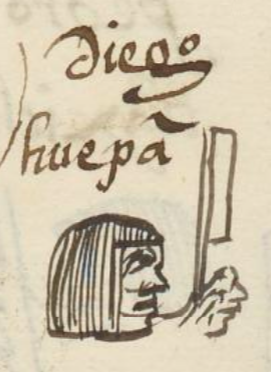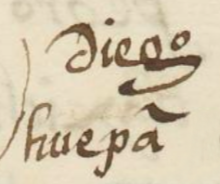Huepan (MH506r)
This black-line drawing of the compound glyph for the personal name Huepan (perhaps "He Dragged Wood" or "A Rough Beam of Wood") is attested here as pertaining to a man. The glyph includes an upright narrow, rectangular banner (panitl) on a stick. Below that, and still touching the handle, is a partial, wrinkled face of an older man (huehue). The face is shown in profile view, facing toward the viewer's right. The banner is also flying toward the right.
Stephanie Wood
A huepantli is a rough beam (in need of refinement) that was used in construction. This could be the original referent for the name as given in the gloss, but it does not match the visuals of the glyph, which are fully phonographic here. There was a famous Huepantzin in the Tlaxcala area at the time of the Spanish invasion of Mexico. (See Luis Reyes García, La Escritura pictográfica en Tlaxcala, 1993, 137.) Perhaps some boys were named after this figure in history. Other examples of the hieroglyph for Huepan (e.g., MH651v and MH904v) appear in the Matrícula de Huexotzinco.
Stephanie Wood
diego
huepā
Diego Huepan
Stephanie Wood
1560
Jeff Haskett-Wood
flags, banners, banderas, viejos, elders, nombres de hombres

huepan(tli), large rough-hewn wooden beam, https://nahuatl.wired-humanities.org/content/huepantli
huepana, to drag a beam of wood, https://nahuatl.wired-humanities.org/content/huepana
huehue, elder, https://nahuatl.wired-humanities.org/content/huehue
pan(itl), banner, flag, https://nahuatl.wired-humanities.org/content/panitl
La Viga(?)
Stephanie Wood
Matrícula de Huexotzinco, folio 506r, World Digital Library, https://www.loc.gov/resource/gdcwdl.wdl_15282/?sp=91&st=image
This manuscript is hosted by the Library of Congress and the World Digital Library; used here with the Creative Commons, “Attribution-NonCommercial-ShareAlike 3.0 License” (CC-BY-NC-SAq 3.0).






